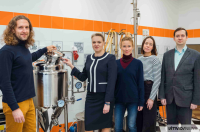Tell us more about your food coatings.
They are based on proteic animal-derived components and plant-based polysaccharides. This way, we attain affinity between the coating’s and products’ surfaces. Our coating’s main difference from polyethylene and plastic bags is that it is edible, and can be digested - of course, you can eat even a plastic package if you mince it, but that is not what you’ll call edible, is it?
For every type of product, we will need to develop a special coating, as it is impossible to create some common, all-purpose solution. The reason is that different products have different chemical and biological properties, and are to be stored in different ways. For now, we develop coatings that increase the shelf-life of vegetables and fruit and give them new properties.
How do these coatings work?
Under normal conditions, when some fruit or vegetable is stored, different irreversible physical, chemical and biological processes start to kick in, including surface oxidation, internal fermentation; particular bacteria also start to live and reproduce inside them. This leads to the product getting spoiled; sometimes you can notice it with the naked eye, sometimes not.
 Alexander Podshivalov
Alexander Podshivalov
“You can eat a fruit and never notice that it’s not fresh. And the current trend is eating your food as fresh as possible, as you’d do on an eco-farm. This is why functional technologies for keeping products as fresh as though they’ve just been picked from the tree are quite relevant,” underlines Alexander Podshivalov.
As of now, the coatings developed at ITMO University are gel-based. The gel has micropores that allow the exchange of vapor and gases with the external atmosphere, desiccation or moisture absorption. Based on the thickness of the coating and particular functional additives, one can control these processes, i.e. their speed and intensity, as well as give the product new commercial qualities.
What’s so good about these coatings?
For instance, by adding antioxidants to the coating’s composition, we can decrease the amount of oxygen that comes in contact with the product’s surface. Thus, it’s possible to decrease surface oxidation. Reinforcing agents made of nanolayers of silicate clay can slow down the product’s desiccation and increase its surface’s physical integrity. Such clay contains metal oxides and minerals that get in the way of vapors and gases. Increasing the integrity allows to protect the product from microdents which is important for soft fruits like grapes.

For other kinds of products, meat, for instance, the coatings are to be different. Fresh meat must not be exposed to oxygen if one wants to increase its shelf-life. This is why it’s commonly frozen, and is perceived as a perishable product.
“Our technologies will help slow down food spoilage, similar to refrigeration technologies. In essence, refrigerators just slow down oxidation and fermentation processes, as well. What is more, by using edible coatings one can improve the products’ commercial qualities,” comments Aleksander Podshivalov.
Compounds that change the products’ qualities can also be part of the coating’s composition. At ITMO University laboratories, for instance, they’ve already created “black” apples. To do that, activated carbon and natural food colorants were added to the film-forming solution. Naturally, by rinsing the apples, one could return them to their original color and smell.
The project’s status
As of now, Aleksander Podshivalov and his team of students focus on the materials science aspect of their project, i.e. studying the coating’s properties. In future, they will conduct practice-oriented research to find out how such coatings affect the products’ storage processes, which will call for complex laboratory experiments: they will have to create special controlled conditions, repeatedly conduct analysis of the products’ gas composition and correct the thickness of gel coating.
Yet, to start commercializing the product, it is also necessary to develop an optimal method of application. For the time being, members of team from the Department of IT in the Fuel and Energy Industry dip the products in a special film-forming solution and dry it afterwards; the coating’s thickness and, consequently, some of its properties depend on the solution’s viscosity.

“This method of applying the coating is no good for industrial applications, as it implies using too much of the solution. An alternative method is to air-spray it. We are currently using it in laboratory conditions, which allows us to keep the coating thin. What is more, microdrops of the gel coating dry a lot faster when using this method,” explains Alexander Podshivalov.
As of now, the team is patenting the technology; before that, they also received financial support from the government. Getting a gold medal at the Bioindustry exhibition is yet another proof that the modern market is interested in technologies offering to prolong food products’ shelf-life.
Apart from the edible coating, amongst ITMO University’s products presented at the exhibition were also new sources of raw protein, the Sonovenus venotonic cream and the AkvaS dry blends for supplementing and purifying chyle.





